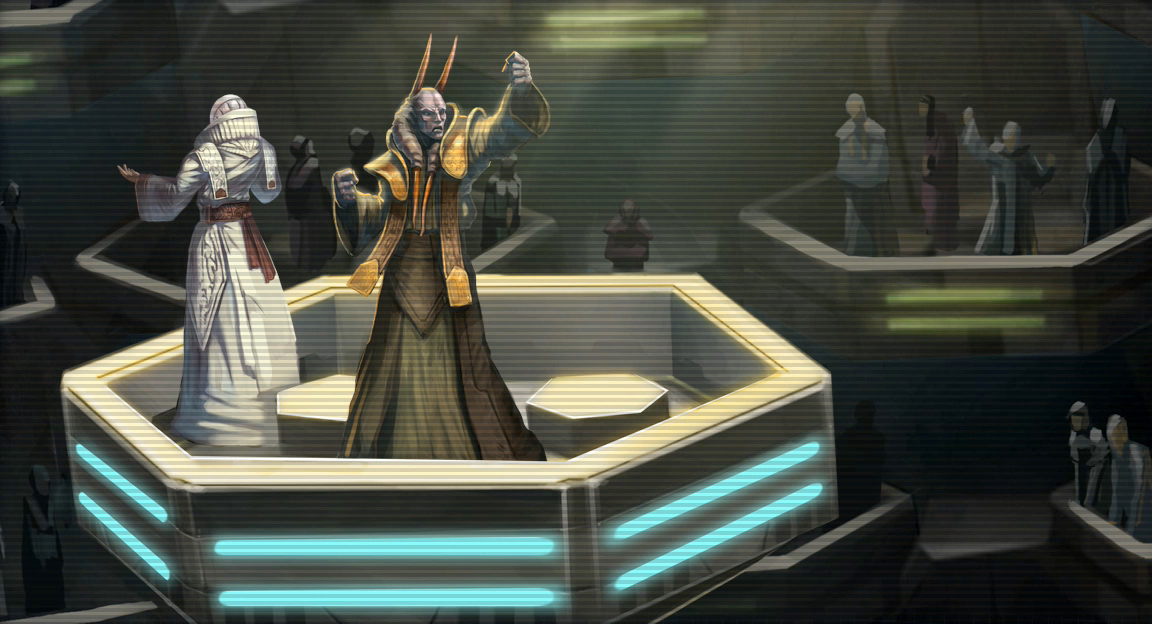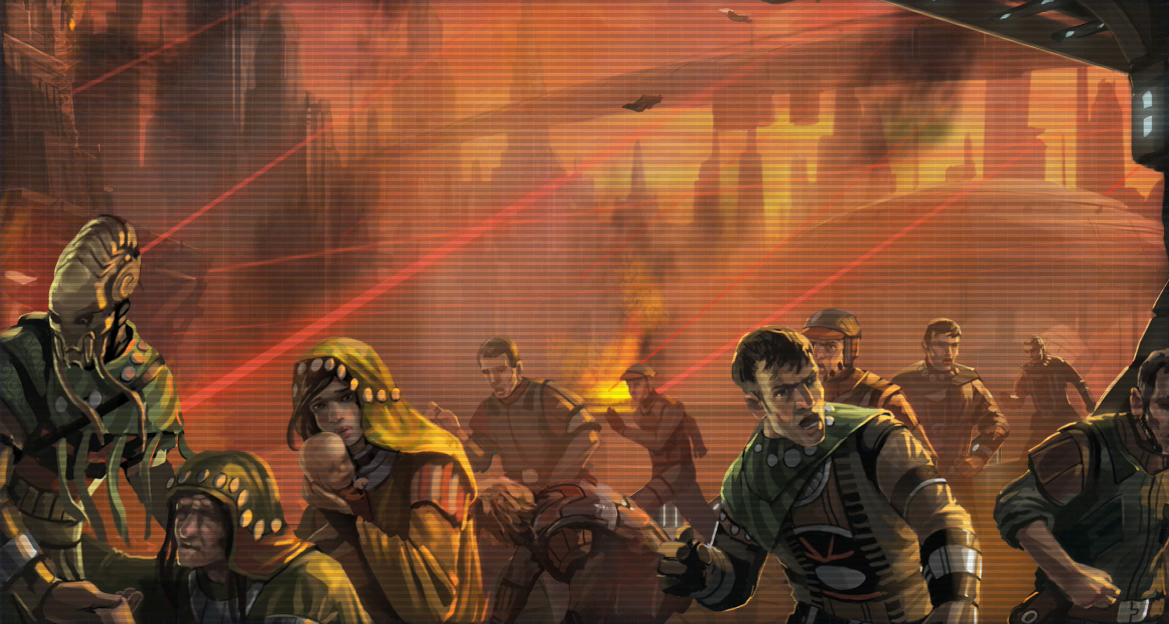In 3680 BBY, the second year of the Great Galactic War, a series of public demonstrations broke out on Coruscant, the capital world of the Galactic Republic, in response to political infighting in the Galactic Senate and the Sith Empire's invasion of the Outer Rim Territories. Tensions began to mount in Galactic City after the Empire made itself known through a series of conquests and massacres in the Outer Rim, but the situation became particularly volatile after the Republic's biting loss of the Tingel Arm and the Empire's siege of the Minos Cluster. While the Senate was mired in political gridlock over how to best respond to the assault, members of the Jedi Order moved forward with a plan to liberate the Minos worlds. Their departure, along with continued inaction from Republic leaders, sent the people of Coruscant into panic, resulting in mass demonstrations consisting of political gatherings, anti-war rallies, and violent riots. The upheaval lasted for days but came to a conclusion as stories of Jedi heroics in the embattled Minos Cluster began to return to Coruscant.

Irate Republic Senators argue over defense strategy.
In 3681 BBY, a revived Sith Empire invaded the territory of the Galactic Republic, sparking the Great Galactic War. In the early days of the war, the Republic suffered repeated losses across the Outer Rim Territories of the galaxy at the hands of the Imperial Military's lightning-fast strikes and well-coordinated tactics. The Republic Military, taken aback by the blitz, was slow to react to the assault, allowing the Imperials to seize greater territory and strike fear into the hearts of Republic citizens. Although the efficiency of the Sith war machine prevented accurate reports from the front lines to spread quickly, news of the Empire's strength soon began to permeate throughout the Republic. Reports of the destruction of a diplomatic convoy at the farthest reaches of the galaxy, the defection of the Aparo sector, the scattering of a Republic fleet in the Tingel Arm, the Sith reclamation of Korriban, and the Empire's massacre of Sluis Van's defenders all served to mount tensions and fears—particularly in the heart of the Republic, which was the capital world of Coruscant.
This sense of panic—part of the Sith Emperor's plan to destabilize the galaxy—was only amplified when the Galactic Senate of the Republic failed to compose a comprehensive defense strategy at an emergency congressional session. Republic leaders disagreed over how the Sith threat should be treated. Some advocated for patient and calculated responses, arguing that the Empire was no different from the many other minor upstart societies that had previously tried to challenge the Republic. Others, including the High Council of the Jedi Order, insisted that the Empire needed to be dealt with swiftly. However, even among these advocates of decisive action, there was disagreement. Senators who feared for the safety of their own worlds protested decisions that left their constituencies undefended against the Sith, resulting in messy deliberations and unnavigable political gridlock. When the negotiations collapsed, diplomatic allies withdrew military support, leaving most Republic sectors to fend for themselves and the people of the Republic in an even greater state of fear.

The invasion of the Minos Cluster catalyzed the discord on Coruscant.
The Sith Empire, largely uninhibited by the Republic, launched a massive invasion of the Minos Cluster the same year. In 3680 BBY, the Jedi, refusing to sit idle as the Sith ravaged the Outer Rim, organized a fleet of battle cruisers to ferry their Knights to the Minos Cluster and defend its people. These developments proved to be a tipping point, and immediately after the Jedi's departure, chaos broke out on Coruscant. Hysteria gripped the populace as news continued to deliver stories of Imperial conquests that horrified many Coruscanti. Some organized mass political rallies in favor of the war effort, while others gathered to demand restraint in the fight against the Sith. Meanwhile, riots and looting wracked sections of the Galactic City, all stemming from fears of the Empire's march toward the Core Worlds.
Jedi who remained on Coruscant were largely powerless to prevent the rioting and lamented seeing fear grip the people of the Republic. The chaos continued for days, until news of the Jedi efforts in the Minos Cluster began to filter back to Coruscant. Reports of their sacrifices and other acts of heroism inspired the people of the Republic, and the riots were extinguished shortly thereafter.
Having been reassured by the efforts of the Jedi, the people of Coruscant refocused their energy from violence and upheaval to more patriotic endeavors. Immediately after the conclusion of the riots, Coruscanti people began registering for duty with the Republic Military to join the Jedi in battle. This boom in military registrations was accompanied by a change in political atmosphere; senators began to approach the issue of defense strategy less selfishly, and instead worked together to compose a comprehensive plan of action. It was after this point that the Republic began to achieve some of its first victories in the war—on the planet Eliad and other battlefields in the Minos Cluster, Jedi were joined by Republic soldiers, and together they fought off the Sith invaders; likewise, a reenergized Republic naval fleet broke the the crippling blockade of the Rimma Trade Route.
Although overt violence in the capital had subsided, the people of Coruscant continued to suffer in the coming years. The onset of the war pushed the Republic into a severe economic depression that continued for decades. The economic woes of the Coruscanti turned into very real concerns over starvation and death in 3661 BBY, when the Mandalorian warrior clans, having allied themselves with the Empire, blockaded the Hydian Way. The blockade severed the movement of food supplies to the Core Worlds, resulting in heavy suffering and the return of mass riots in the lower levels of Coruscant. In the years after the Great Galactic War, Jedi Grand Master Satele Shan recalled her memories on Coruscant during the rioting of 3680 BBY. She added her experiences to a primary source volume on the war, noting her own sorrow over the desperation on Coruscant, as well as her optimistic appraisal of what the event revealed about the Republic's democracy.
The Coruscant riots and demonstrations of 3,680 BBY were first introduced to Star Wars lore in 2011, with the release of The Journal of Master Gnost-Dural, a short reference work included in Collectors Edition bundles of Star Wars: The Old Republic. The book was written by Robert Chestney under the personas of Jedi Masters Gnost-Dural and Satele Shan, the latter of whom recounts the demonstrations from an in-universe, first person perspective.